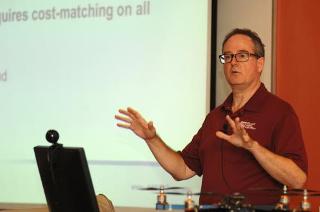Oct 16 2015
Established in 2007, the New Mexico State University Physical Science Laboratory’s Unmanned Aircraft Systems Flight Test Center is the first of its kind.
 New Mexico State University Physical Science Laboratory Interim Deputy Director Henry Cathey speaks at a Scholarly Excellence Rally honoring NMSU’s Physical Science Laboratory for its work with the Federal Aviation Administration Center for Excellence for Unmanned Aircraft Systems Research. (NMSU photo by Karrie Lucero)
New Mexico State University Physical Science Laboratory Interim Deputy Director Henry Cathey speaks at a Scholarly Excellence Rally honoring NMSU’s Physical Science Laboratory for its work with the Federal Aviation Administration Center for Excellence for Unmanned Aircraft Systems Research. (NMSU photo by Karrie Lucero)
In the last eight years, NMSU’s UAS FTC has become the most accomplished and most experienced Federal Aviation Administration-approved UAS test facility in the country.
NMSU’s UAS FTC provides direct access to more than 15,000 square miles of airspace, and was the first civil UAS test facility that provided direct, available access to restricted airspace – a must for testing developmental aircraft or multi-aircraft scenarios.
Henry Cathey, interim deputy director of NMSU’s Physical Science Laboratory, was honored at NMSU’s Scholarly Excellence Rally Friday, Oct. 9.
“The Flight Test Center in Las Cruces has been operating for a number of years, and it’s not only a unique resource for the state of New Mexico, but it is a unique resource for the entire country,” Cathey said. “It’s state-of-the-art, cutting-edge, and it’s very exciting that New Mexico is leading the way in this area.”
In May 2015, the FAA announced that the Alliance for System Safety of UAS through Research Excellence (ASSURE) would operate a new National Center of Excellence for UAS. NMSU is a core member-university on a team, which is comprised of 15 universities and six affiliates.
As a core university of ASSURE, NMSU is helping lead the partnership of academic and industry members that will begin a new era of commercial unmanned aircraft research, development and integration into the nation’s airspace. Dallas Brooks, NMSU UAS research and development strategic manager, is the principle investigator on the ASSURE project and co-chairs the Federal UAS Science and Research Panel, which oversees and coordinates UAS research conducted by the FAA, NASA, the Department of Defense, and the Department of Homeland Security.
The center of excellence will supply research to the FAA and UAS industry to increase the potential uses of unmanned systems with minimal changes to the current system regulating manned aircraft.
The center of excellence research areas will include: detect and avoid technology; low-altitude operations safety; control and communications; spectrum management; human factors; compatibility with air traffic control operations; and training and certification of UAS pilots and other crewmembers.
“We are supporting and trying to make the skies safer for using things like UAS or unmanned aircraft systems in the national airspace,” Cathey said. “We have been tasked to look at detect and avoid technology on how we can integrate things from small UAS up to things with a 15- to 20-foot wingspan into national airspace safely.
“The detect and avoid research area focuses on issues related to the detection of potential threats to remain well clear and avoid collisions. It explores sensors, the data produced from sensors, the management and use of that data, and the operational outcome that is considered safe and acceptable,” he said.
In this research area, NMSU is evaluating the requirements for an airborne or ground-based Detect and Avoid system compatible with small UAS (55 pounds and less) operating in limited portions of the National Air Space to comply with the regulations and not increase the risk to other aircraft or people on the ground, beyond what is currently in effect. Additionally, NMSU is accessing the requirements for software along with what are the most feasible airborne or ground-based sensors.
ASSURE will form teams between its member universities, government agencies and industry partners to address both government and commercial UAS challenges.
“Each of those universities has specific skills and abilities, and the idea is to marry all of the technical expertise to provide real research answers for flight safety in the National Air Space,” Cathey said.